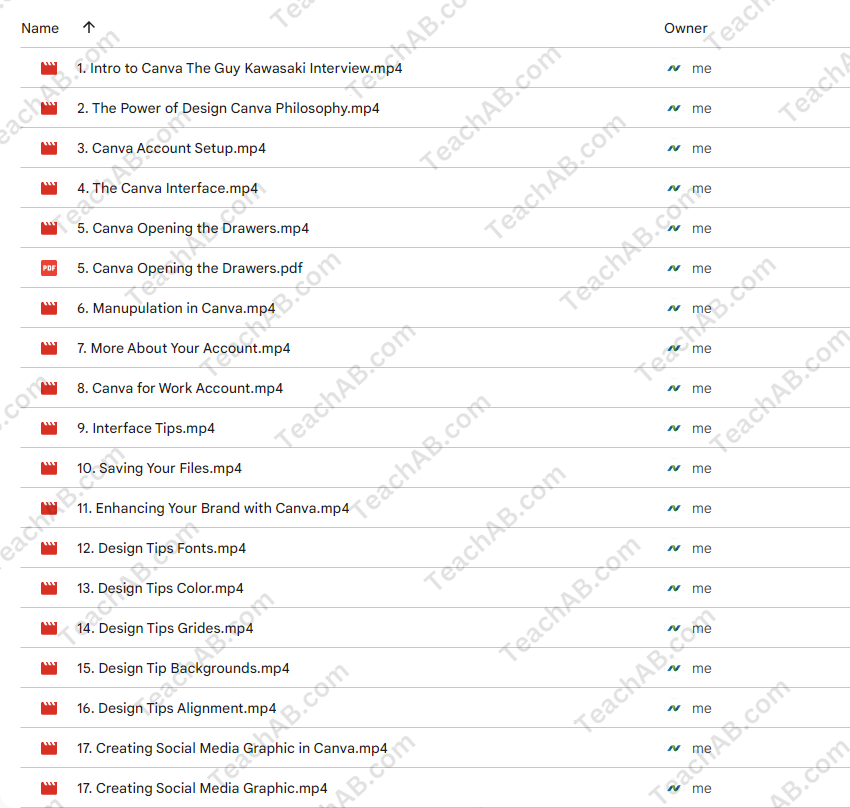Easy Graphic Design for Your Business with Canva By Matt Stevenson
$14,00 $5,00
Easy graphic design for your business with Canva by Matt Stevenson – Digital Download!
Let’s embark on a captivating adventure to uncover remarkable insights that spark your curiosity and elevate your understanding

Easy Graphic Design for Your Business with Canva By Matt Stevenson
Overview

Easy graphic design for your business with Canva by Matt Stevenson
In an era where visual communication reigns supreme, the need for effective graphic design is more critical than ever, especially for businesses wanting to captivate their audience. Matt Stevenson’s course, Easy graphic design for your business with Canva, emerges as a beacon for individuals and businesses longing to transform their ideas into stunning visuals without the complex jargon typically associated with design. This course not only demystifies the world of graphic design but also invites everyone from novices to seasoned marketers to unleash their creativity. With a simple and intuitive interface, Canva stands ready to empower users, crafting a journey where anyone can learn to express their brand’s narrative visually.
User-friendly interface
The foundation of the course lies in its in-depth introduction to Canva’s user-friendly interface. Imagine walking into a vast art studio with all the tools at your disposal, yet tailored to your skill level. Stevenson’s course offers exactly that experience, allowing users to navigate the platform effortlessly. The drag-and-drop functionality serves as a powerful metaphor here it mirrors the ease of placing pieces in a puzzle. This intuitive feature enables users to create designs that not only look professional but also align with their vision.
The course meticulously breaks down each element of the interface, ensuring that even those with minimal experience can find their footing. An implicit comparison can be drawn to learning to ride a bicycle thanks to the straightforward guidance through the course, users quickly find their balance and start creating. From menus to tools, students can access various functionalities, facilitating a seamless creative process.
What further enhances this experience is the built-in collaboration feature that allows users to share their designs in real-time with team members or stakeholders. This aspect transforms the daunting graphic design process into a collaborative endeavor, reinforcing the idea that creativity thrives in community and shared insight.
Accessibility for all skill levels
One of the most significant barriers in the field of graphic design is the myth of exclusivity. Many believe that only those with formal training can produce effective designs. However, Stevenson’s course effectively shatters this notion. By focusing on accessibility, he empowers users from all backgrounds to engage with and master design concepts.
The course illustrates that design is not just for artists but is inherently a form of communication everyone has a story to tell. To facilitate this understanding, Stevenson includes practical exercises and examples that demonstrate the effective application of design regardless of skill level. This approach encourages participants to take ownership of their designs, fostering a sense of confidence that is often lacking among non-designers.
Furthermore, the emphasis on practical applications provides participatory learning experiences. Students learn to create a variety of marketing materials, from eye-catching social media graphics to professional presentations. This kind of hands-on engagement similar to learning a new language through conversation rather than textbooks makes the principles of design tangible and relatable.
Key Points:
- Target Audience: Non-designers and individuals with basic design experience.
- Practical Exercises: Focus on real-world applications in marketing and brand communication.
- Empowerment: Equipping students to express their ideas through visuals.
Practical applications
Making graphic design accessible paves the way for practical applications that are essential for modern businesses. Stevenson’s course recognizes that the pace of the business world requires professionals to be adaptable, and the ability to create marketing materials on the fly is invaluable. Emphasizing real-world relevance, the curriculum teaches students how to produce a range of marketing materials, enabling them to respond swiftly to market demands, and seize new opportunities.
Students delve into creating social media graphics, presentations, and promotional content. This is akin to a chef learning to cook multiple cuisines; proficiency in various styles allows for versatility and innovation in the kitchen or in this case, the design studio. Moreover, having access to Canva’s extensive library of templates and stock images significantly reduces the time and effort involved in design.
Breakdown of Practical Applications:
- Social Media Graphics: Essential for engaging audiences on platforms like Instagram and Facebook.
- Presentations: Tools to create impactful visuals that communicate complex ideas simply.
- Promotional Material: Designs that emphasize brand identity while appealing to target demographics.
This practical focus ensures that participants leave the course not just with theoretical knowledge but with concrete skills they can apply immediately to their business endeavors.
Educational resources
A crucial element that Stevenson integrates into his course is the incorporation of educational resources that enhance the learning experience. Rather than simply teaching how to use the tools, he elaborates on fundamental design principles, including color theory, typography, and layout. These concepts serve as the building blocks of effective design, much like understanding grammar is essential to writing.
Through this course, learners are exposed to the importance of maintaining brand integrity. The visual consistency established through thoughtful design builds trust and fosters recognition. For example, consistent use of colors that reflect a brand’s personality can evoke emotions and establish a connection with the audience. This strategic insight helps participants avoid common pitfalls, ensuring their designs are not only beautiful but also effective in achieving business goals.
Educational Highlights:
- Color Theory: Understanding how colors can influence perception and emotions.
- Typography: The impact of font choices on readability and brand voice.
- Layout Principles: Techniques for creating balanced and engaging designs.
By emphasizing these principles, Stevenson ensures that students walk away equipped not just with Pinterest-worthy designs but with the strategic thinking required to make those designs resonate with their audience.
Collaboration features
As remote work becomes increasingly common, the ability to collaborate seamlessly is essential for businesses. Stevenson highlights Canva’s collaboration features, which allow teams to work together in real-time. This capability is akin to musicians playing in sync; each member can contribute their unique talents while staying aligned towards a common goal.
These collaborative tools enable businesses to streamline their design workflows, allowing for faster and more efficient content creation. Whether a team member is located in another city or halfway around the globe, they can join in the creative process, providing feedback or making adjustments as necessary. This real-time collaboration eliminates the prolonged email chains and encourages a more dynamic, interactive approach to graphic design.
Benefits of Collaboration Tools:
- Real-time Editing: Instant updates and modifications as team members brainstorm.
- Feedback Loops: Easier to provide and implement feedback on designs.
- Shared Resources: Access to a common library of images, templates, and designs.
Stevenson’s course not only prepares students to create compelling designs individually but also trains them to leverage collective creativity, enhancing the overall output quality and team synergy.
Cost-effectiveness
In today’s economic landscape, where budgets are a primary concern for many businesses, Stevenson’s insights into the cost-effectiveness of Canva are particularly noteworthy. He breaks down the platform’s pricing structure, which includes a free plan, making it accessible to individuals and small businesses with limited resources.
This affordability is complemented by the additional benefits offered in the pro version. Businesses that require advanced features, such as brand kits, unlimited storage, and premium templates, can upgrade at a fraction of the cost compared to traditional design services. This makes Canva not just a tool, but a strategic asset for any organization focused on growth without breaking the bank.
Pricing Breakdown:
- Free Plan: Basic tools available for all users.
- Pro Version: Advanced features at competitive prices.
The discussions around pricing highlight that the power of professional-quality design does not have to come with a hefty price tag validating the idea that small businesses can compete visually with larger corporations.
Conclusion
In a world where effective communication is often visual, figuring out how to harness that potential without extensive design knowledge can be daunting but Matt Stevenson’s course, Easy graphic design for your business with Canva, breaks down those barriers expertly. Through a user-friendly interface, practical applications, and a focus on essential design principles, Stevenson empowers participants not just to create designs but to tell stories that engage and resonate with their audiences.
From accessibility for all skill levels to collaboration tools that enhance teamwork, every aspect of the course is thoughtfully considered, ensuring that anyone can walk away equipped to elevate their business’s visual communication. Whether you are a marketing professional, a small business owner, or someone seeking to enhance your creative skillset, this course serves as a valuable resource, proving that effective graphic design is within reach for all.
Frequently Asked Questions:
Innovation in Business Models: We use a group purchase approach that enables users to split expenses and get discounted access to well-liked courses. Despite worries regarding distribution strategies from content creators, this strategy helps people with low incomes.
Legal Aspects to Take into Account: Our operations’ legality entails several intricate considerations. There are no explicit resale restrictions mentioned at the time of purchase, even though we do not have the course developers’ express consent to redistribute their content. This uncertainty gives us the chance to offer reasonably priced instructional materials.
Quality Control: We make certain that every course resource we buy is the exact same as what the authors themselves provide. It’s crucial to realize, nevertheless, that we are not authorized suppliers. Therefore, the following are not included in our offerings: – Live coaching sessions or calls with the course author.
– Entry to groups or portals that are only available to authors.
– Participation in closed forums.
– Straightforward email assistance from the writer or their group.
Our goal is to lower the barrier to education by providing these courses on our own, without the official channels’ premium services. We value your comprehension of our distinct methodology.
Be the first to review “Easy Graphic Design for Your Business with Canva By Matt Stevenson” Cancel reply
You must be logged in to post a review.



















Reviews
There are no reviews yet.